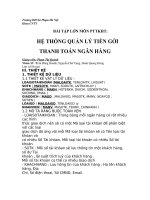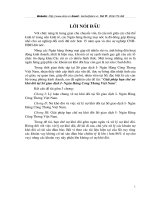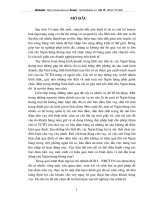i excecutive summary
Bạn đang xem bản rút gọn của tài liệu. Xem và tải ngay bản đầy đủ của tài liệu tại đây (3.39 MB, 21 trang )
<span class="text_page_counter">Trang 1</span><div class="page_container" data-page="1">
ACADEMIC REPORT
GROUP ASSIGNMENT – ECO 121
Semester: SUMMER - Class: IB1804 - Year 2023Lecture: Nguyễn Minh Ngọc Quỳnh
CHINA
</div><span class="text_page_counter">Trang 2</span><div class="page_container" data-page="2">1Table of Contents
</div><span class="text_page_counter">Trang 3</span><div class="page_container" data-page="3">I. EXCECUTIVE SUMMARY
In September 2015, the leaders of countries, including Chinese President Xi Jinping, attended theUnited Nations Development Summit and adopted the 30-Year Agenda for Sustainable Development,thereby creating a momentous topic for the next 15 years.
Being the largest developing country in the world, China has always prioritized development. Thiswas emphasized during the Fourth Session of the Twelfth National People's Congress on March 16,2016, when the Outline "13th Five-Year Plan" was approved. The plan focuses on innovating,coordinating, greening, developing, opening up to the world, and striving for win-win cooperation.China aims to prioritize growth that benefits people's well-being by stepping up economic, political,and cultural development, building a society, creating ecological civilization, and ensuring theconstruction of a well-off society comprehensively according to the plan.
China also values the new-style international relations program with mutual benefit as the core. Thisinvolves establishing partnerships and comprehensive cooperation, promoting development in threemajor areas: economy, society, and environment. Countries should implement this program based onthe principle of “common but differentiated responsibility,” taking into account their own conditionsand capabilities.
II. GDP
China is the second-largest economy in the world and has been a major contributor to global growth over the past few decades. However, recent years have seen a slowdown in China's economic growth.This has raised concerns about the sustainability of China's economic model and the impact it could have on the global economy.
In 2019, China's GDP growth rate was 5.95%, which was already a significant decline from previous years. However, the COVID-19 pandemic in 2020 caused a further decline in GDP growth rate, dropping to 2.24%. The pandemic had a severe impact on China's economy, with the country being one of the first to be hit by the virus. The lockdowns and restrictions severely impacted businesses, supply chains, and employment, leading to a significant decline in economic activity.
Despite this, China's economy has shown signs of recovery in 2021 with a remarkable 8.45%, which was the highest growth rate in decades. This growth can be attributed to several factors, including thegovernment's stimulus measures, the rebound of the manufacturing sector, and the continued growth of e-commerce and online activities.
In 2022, China's GDP increased by 2.99%, much lower than the official target of "about 5.5%" and sharply lower than the growth rate of 8.45% in 2021. If not included growth of 2.2% after the first Covid-19 outbreak in 2020.
However, it is expected that China's GDP growth rate will slow down in the coming years. The ongoing pandemic continues to pose challenges to the economy, and the trade war with the United States has also affected China's GDP. The trade war with the United States caused a 0.8% reduction inChina's GDP growth rate in 2019. Although the trade tensions eased in 2020, the Biden administrationhas taken a tough stance on China, which could further affect China's GDP growth.
</div><span class="text_page_counter">Trang 4</span><div class="page_container" data-page="4">Figure 1.1. Growth rate of real GDP in China from 2012 to 2022
Source: Statista.
Note: GDP= Gross Domestic Product.
Benefitting from the effective control of COVID-19 in 2021, China's service sector experienced asteady recovery, signalling a positive outlook for the country's economic growth. Following theunprecedented challenges faced in 2020, the contribution of the service sector to China's GDP growthrebounded to 54.9% in 2021, showcasing a notable improvement from the previous year.
The resurgence of the service sector played a vital role in revitalizing the Chinese economy. As thepandemic restrictions were gradually lifted, sectors such as retail, hospitality, tourism, transportation,and financial services experienced a resurgence in activity. Consumers regained confidence inengaging with these industries, leading to increased spending and demand for services. This positivetrend contributed to the recovery of the service sector and its subsequent impact on overall economicgrowth.
Nevertheless, despite the encouraging progress, the service sector has not yet fully returned to its pre- pandemic levels. The lingering effects of the COVID-19 pandemic, coupled with ongoing global uncertainties, continue to pose challenges for the sector. Consumer behavior has shifted, with some individuals remaining cautious about discretionary spending and travel, impacting the recovery of certain service industries. Furthermore, international travel restrictions have affected sectors like tourism, limiting the influx of foreign visitors and impacting revenue.
</div><span class="text_page_counter">Trang 5</span><div class="page_container" data-page="5">Figure 2.2. Sectors contribution to GDP growth
Source: IMF World Economic Outlook.
In the first semester of 2022, the construction and real estate sectors in China experienced a relativedecrease in their contribution to GDP compared to the previous year. The construction sector'scontribution shrank from 7.2% in 2020 to 6.3% in 2022, while the real estate sector saw a declinefrom 7.3% to 6.7% during the same period.
This relative decrease was triggered in 2020 by the Government's efforts to tighten its regulatorypolicy of these sectors. In 2020, the government recognized the need to address certain challenges andrisks associated with the construction and real estate industries. As a result, they implementedmeasures aimed at curbing speculative investment, reducing housing market volatility, and promotingsustainable development.
The government's regulatory policies included stricter control over land supply, tightening ofmortgage lending regulations, and increased scrutiny on property developers' financing activities.These measures were intended to prevent excessive speculation, curb rising property prices, and fostera more stable and sustainable housing market. While these policies were necessary for long-termeconomic stability, they had an immediate impact on the construction and real estate sectors.The tightening of regulatory policies had several effects on the construction sector. It led to a decreasein the number of new construction projects, as developers became more cautious in their investments.Additionally, the availability of land for development became more limited, affecting the overallgrowth of the construction industry. As a result, the sector's contribution to GDP experienced adecline. Similarly, the real estate sector was affected by the regulatory changes. The implementationof stricter lending regulations made it more challenging for potential homebuyers to obtain mortgages,leading to a decrease in housing demand. This, in turn, impacted property sales and slowed down thegrowth of the real estate sector. Consequently, the sector's contribution to GDP also experienced adecline.
</div><span class="text_page_counter">Trang 6</span><div class="page_container" data-page="6">Figure 2.3 Construction and real estate share of GDP
Source: IMF World Economic Outlook.
In 2021, China's economy witnessed a notable shift in its growth drivers, with consumptionreclaiming its position as the primary engine of economic expansion. Consumption contributed to asubstantial 65.4% of China's GDP growth, signalling a robust recovery in domestic demand andconsumer confidence. This resurgence in consumption was a significant milestone for the Chineseeconomy, reflecting the successful control of the COVID-19 pandemic and the subsequentrevitalization of consumer spending.
Alongside consumption, exports also played a vital role in driving China's economic growth in 2021.With the gradual recovery of global trade and increased demand for Chinese goods, exportscontributed to 20.9% of the country's growth. China's manufacturing prowess and export-orientedindustries played a pivotal role in capitalizing on the global economic recovery and strengthening thenation's external trade position.
However, amidst the resurgence of consumption and the strong performance of exports, thecontribution of investment to China's GDP growth experienced a notable decline. Investment'scontribution dropped from an average of 37.2% in the three years preceding the COVID-19 pandemic(2017-2019) to a mere 13.7% in 2021, marking the lowest level in nearly three decades.
</div><span class="text_page_counter">Trang 7</span><div class="page_container" data-page="7">Figure 2.4. Contribution to GDP growth
Source: IMF World Economic Outlook.
China's trade sector demonstrated exceptional strength and resilience in 2021, achieving remarkablegrowth in the total value of imports and exports. The combined value of China's trade surged by animpressive 21.4%, reaching 39.1 trillion RMB (approximately 5.8 trillion USD). This remarkableperformance reflects China's continued integration into the global economy and its pivotal role as amajor player in international trade.
China's major trading partners in 2021 closely mirrored those of previous years, with the rankingremaining consistent. The Association of Southeast Asian Nations (ASEAN) maintained its positionas China's largest trading partner, accounting for 15% of the total trade value. The close geographicalproximity, robust economic ties, and strong trade relationships between China and ASEAN membercountries have contributed to their sustained trade volumes.
The United States, despite the challenges posed by ongoing trade tensions, remained an importanttrading partner for China, occupying the third position with a 13% share of the total trade value. Theeconomic interdependence between the world's two largest economies, coupled with their extensivetrade linkages across various sectors, continues to shape their bilateral trade relationship.
Japan, a longstanding trading partner of China, ranked fourth in 2021, accounting for 7% of the total trade value. The proximity of the two nations, as well as the complementary nature of their economies, has fostered a mutually beneficial trade partnership.
</div><span class="text_page_counter">Trang 8</span><div class="page_container" data-page="8">Figure 2.5. Trade value
Source: IMF World Economic Outlook.
China's central and local government debt exhibited a continuous upward trajectory in 2021,following a substantial surge experienced in the previous year. By the end of 2021, the outstandinggovernment debt reached a significant amount of 53.74 trillion RMB, equivalent to 47.4% of thecountry's GDP. This growing debt burden reflects the government's efforts to stimulate the economy,address the challenges posed by the COVID-19 pandemic, and support key sectors.
The increase in government debt can be attributed to various factors. In response to the economicfallout caused by the pandemic, the Chinese government implemented extensive fiscal measures,including increased government spending, tax cuts, and infrastructure investment, to bolster economicrecovery. These actions resulted in a surge in debt issuance to finance these expansionary policies andsupport vital sectors of the economy.
It is worth noting that despite the increase in government debt, China's overall debt-to-GDP ratioremained within a manageable range. With a debt-to-GDP ratio of 47.4%, China's debt burden islower than that of many other major economies. The government has been proactive in implementingmeasures to control and mitigate potential risks associated with debt accumulation, ensuring a stableeconomic environment.
In terms of budget deficit, China recorded a deficit equivalent to 3.1% of GDP in 2021. This deficitreflects the difference between government expenditures and revenues. The budget deficit serves as an
</div><span class="text_page_counter">Trang 9</span><div class="page_container" data-page="9">important tool for the government to inject liquidity into the economy, finance public investment, andsupport social welfare programs.
For 2022, the government has set a target deficit-to-GDP ratio of 2.8%. This indicates a measuredapproach to fiscal policy, aiming to strike a balance between supporting economic growth andensuring fiscal sustainability. The government's focus on maintaining a reasonable deficit levelhighlights its commitment to managing debt risks and promoting long-term economic stability.Figure 2.6. Budget deficit and goverment debt
Source: IMF World Economic Outlook.
Foreign direct investment (FDI) into China demonstrated significant growth in 2021, reaching arecord high of 173 billion USD, reflecting the country's attractiveness as an investment destination.This represents a substantial increase of 20% compared to the previous year, underscoring China'sresilience and appeal to international investors despite the challenges posed by the global economiclandscape.
China's ability to attract FDI can be attributed to several factors. Firstly, the country's large consumermarket, with a burgeoning middle class and rising disposable incomes, presents significantopportunities for businesses seeking to tap into a vast consumer base. Additionally, China's robustinfrastructure, skilled workforce, and advanced manufacturing capabilities further enhance its appealto foreign investors.
In contrast to FDI, outbound direct investment (ODI) from China has experienced fluctuations. ODIrefers to Chinese companies' investments in foreign markets. While the growth of ODI had beenrobust in previous years, it has been on a decreasing trend recently. In 2021, ODI amounted to 145billion USD, indicating a decline compared to previous years.
</div><span class="text_page_counter">Trang 10</span><div class="page_container" data-page="10">The decrease in ODI can be attributed to several factors. Firstly, the Chinese government hasimplemented stricter capital controls and regulations on outbound investments to manage risksassociated with capital outflows and safeguard the stability of the financial system. These measuresaim to prevent excessive overseas investments and ensure the prudent use of capital.
Figure 2.7. ODI and FDI
Source: IMF World Economic Outlook.Note: FDI= Foreign direct investment.
ODI= Outbound direct investment.III.CPI
According to NBS, the strain on pork supply in China has lessened due to good improvements in animal output, a strategy of exporting pigs from stockpiles, and an increase in imports.
OCBC bank's Tommy Xie predicts that consumer prices in the world's second-largest economy wouldfall modestly in 2020, however hog prices are expected to stay high in the first half of this year.
</div><span class="text_page_counter">Trang 11</span><div class="page_container" data-page="11">Overall, China's CPI has been relatively constant in recent years, with an annual growth of roughly 2.5% on average during the last decade.
CPI China in 2020:
In China, this is the greatest growth in eight years. Food prices grew by more than 20.6% incomparison to the same time in 2019, and by 3.2% in comparison to December 2019, adding to a4.1% increase in the consumer price index (CPI). In which the price of pork grew the greatest, at116%, more than double that of the previous month, while vegetables jumped by 17% due to thewinter and Tet season.
The significant increase in the consumer price index, according to the chairman of China's NationalBureau of Statistics, was driven by price hikes over the Tet holiday season, as well as the nCovepidemic. The pandemic nCoV has disrupted the supply chain, contributing to soaring food prices.There is yet no evaluation of the impact of industries and businesses being shuttered for extendedperiods of time owing to the pandemic. Experts predict that the Central Bank of China will make amove in the future monetary policy management. Analysts predict that China's CPI will riseconsiderably in February 2020, owing to the ongoing outbreak and the disruption of commoditiessupply chains caused by the virus.
Overall, China's CPI has been relatively constant in recent years, with an annual growth of roughly2.5% on average during the last decade. The COVID-19 pandemic, on the other hand, had asubstantial impact on the Chinese economy in 2020, with interruptions to global supply networks andlower consumer demand making it difficult to maintain steady inflation levels. Despite theseobstacles, the CPI stayed within the government's 3% goal range.
CPI China in 2021
According to the World Bank, China's CPI in 2021 will reach 129.37, an increase of 1.26 compared to last year's CPI, and have a CPI growth rate of 0.98%. The increase is very small but in general it is still considered safe since the Covid 19 pandemic. (Solieukinhte.com)
In January 2021, China's CPI increased by 1% over the same period last year, but decreased by 0.3% compared to December 2020. By February, this index had progressed, slightly increasing 0.1% but decreased by 0.4% to only 0.6% compared to February 2020. These are the only 2 months with a decrease in CPI compared to the same period last year.
Following that, China's CPI was consistently negative from March to June when compared to the previous months, but this index gradually increased over the same period last year, reaching the highest level in the second quarter of May with a growth rate of 1.3%, indicating that China has devised solutions to gradually recover its economy from the source of the COVID-19 epidemic.CPI increased by 0.3% in July over June and by 1% over the same period last year.
The indicator declined by 0.2% in August, climbed by 0.8% compared to August of last year, and increased by 0.1% compared to July. China's CPI rose 0.6% on average during the last eight months. However, if the core CPI, which excludes food and energy costs, is up 1.2%, this suggests that food and energy prices have declined year on year. (Phạm Sỹ Thành. 2021
CPI fell slightly from July to September before skyrocketing by around 0.7% from September to October. The October CPI climbed by 1.5% over the previous year and by 0.7% over September. According to the National Bureau of Statistics of China, China's CPI increased by 2.3% in November,the only figure above 2 for the entire year 2021. One reason for this is the cost. Fresh vegetables and some other foods increased sharply, with vegetable prices increasing by 30.6%, egg prices increasing by 20.1%, and freshwater fish prices increasing by 18% over the same period last year, but pork
</div>






